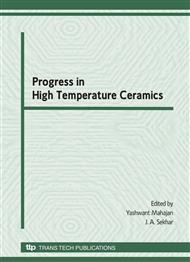[1]
A. L. Chamberlain, W. G. Fahrenholtz, G. E. Hilmas, D. T. Ellerby: Key Eng. Mater. Vol. 264 (2004), p.493.
Google Scholar
[2]
Federick Monteverde, Stefano Guicciardi and Alida Bellosi: Mater. Sci. Eng. Vol. A346 (2003), p.310.
Google Scholar
[3]
Stanley R Levine, Elizabeth J. Opila, Michael C. Halbig, James D. Kiser, Mrityunjay Singh and Jonathan A. Salem: J. Eur. Ceram. Soc. Vol. 22 (2002), p.2757.
Google Scholar
[4]
Mark M. Opeka, Inna G. Talmy, Eric. J. Wuchina, James A. Jaykoski, and Samuel J. Causey: J. Eur. Ceram. Soc. Vol. 19 (1999), p.2405.
Google Scholar
[5]
Federick Monteverde: Comp. Sci. Tech. Vol. 65(11-12) (2005), p.1869.
Google Scholar
[6]
W. G. Fahrenholtz, G. E. Hilmas, A. L. Chamberlain and J. W. Zimmermann: J. Mater. Sci. Vol. 39 (2004), p.5951.
Google Scholar
[7]
Sumin Zhu, W.G. Fahrenholtz, G.E. Hilmas: J. Eur. Ceram. Soc. Vol. 27 (2007), p. (2077).
Google Scholar
[8]
Xinghong Zhang, Lin Xu, Shanyi Du, Jiecai Han, Ping Hu, Wenbo Han: Mater. Lett, in press.
Google Scholar
[9]
Alireza Rezaie, William G. Fahrenholtz, Gregory E. Hilmas, J. Eur. Ceram. Soc. Vol. 27 (2007), p.2495.
Google Scholar
[10]
E. V. Clougherty, D. Kalish and E. T. Peters: Airforce Materials Laboratory Technical Report AFML-TR-68-190, Wright-Patterson Airforce Materials Laboratory, Dayton, OH, USA (1968).
Google Scholar
[11]
Federic Monteverde and Alida Bellosi: Scripta Mater. Vol. 46 (2002), p.223.
Google Scholar
[12]
Jeffrey Bull, Michael J. White, and Larry Kaufman: US Patent 5, 750, 450. (1998).
Google Scholar
[13]
R. E. Loehman: Industrial Heating, January 11 (2004).
Google Scholar
[14]
ASTM C 1259-01, Annual book of ASTM standards, section 15, American Society for Testing and Materials, Philadelphia, PA, USA (2001).
Google Scholar
[15]
ASTM E 399-83, Annual book of ASTM standards, section 3, p.500, American Society for Testing and Materials, Philadelphia, PA, USA (1990).
Google Scholar
[16]
ASTM C 1161-94, Annual book of ASTM standards, pp.309-15, American Society for Testing and Materials, Philadelphia, PA, USA (1996).
Google Scholar
[17]
K. Nihara, R. Morena, D.P.H. Hasselman, in: Brittle Matrix Composites 2, R.C. Bradt, D.P.H. Hasselman, F.F. Lange (Eds. ), Elsevier Applied Science, New York (1983), p.84.
Google Scholar
[18]
G. Fargas, D. Casellas, L. Llanes, and M. Anglada: J. Eur. Ceram. Soc. Vol. 23 (2003), p.107.
Google Scholar
[19]
Pernilla Petterson, Mats Johnsson: J. Eur. Ceram. Soc. Vol. 23 (2003), p.309.
Google Scholar
[20]
ShuQin Li, Yong Huang, YongMing Luo, ChangAn Wang, CuiWei Li: Mater. Lett. Vol. 57 (2003), p.1670.
Google Scholar
[21]
R. Telle, L. S . Sigl and K. Takagi, in: Handbook of Ceramic Hard Materials, edited by R. Riedel, Wiley-VCH, Weinheim (2000), p.803.
Google Scholar
[22]
M.E. Fine: Scripta Metall. Vol. 15 (1981), p.523.
Google Scholar
[23]
M.S. Zedalias, M.V. Ghate and M.E. Fine: Scripta Metall. Vol. 19 (1985), p.647.
Google Scholar
[24]
R. Mitra and Y.R. Mahajan: Bull. Mater. Sci. Vol. 18(4) (1995), p.405.
Google Scholar
[25]
P.L. Swanson, C.J. Fairbanks, B.R. Lawn, Y. -W. Mai, and B.J. Hockey: J. Am. Ceram. Soc., Vol. 70 (4) (1987), p.279.
Google Scholar
[26]
Information available on http: /www. azom. com/details. asp?ArticleID=261.
Google Scholar
[27]
Charles C. Sorrell, Vladimir S. Stubican, Richard C. Bradt: J. Am. Ceram. Soc., Vol. 69(4) (1986), p.317.
Google Scholar
[28]
Tsuchida Takeshi, Yamamoto Satoshi: J. Mater. Sci., Vol. 42(3) (2007), p.772.
Google Scholar


